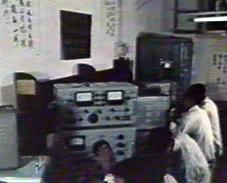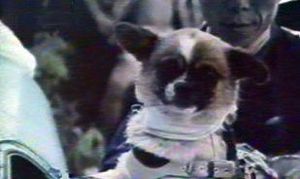
Home - Search - Browse - Alphabetic Index: 0- 1- 2- 3- 4- 5- 6- 7- 8- 9
A- B- C- D- E- F- G- H- I- J- K- L- M- N- O- P- Q- R- S- T- U- V- W- X- Y- Z
T-7
 T-7 Launch |
Status: Retired 1969. First Launch: 1960-09-01. Last Launch: 1969-01-01. Number: 3 . Payload: 25 kg (55 lb). Gross mass: 1,138 kg (2,508 lb). Height: 8.00 m (26.20 ft). Diameter: 0.45 m (1.47 ft). Apogee: 58 km (36 mi).
The Shanghai Institute for Electromechanical Design began development of China's first sounding rocket, the T-7, in October 1959. The first step was production and test of the T-7M subscale prototype. Under the leadership of Wang Xi Ji , China's first sounding rocket launch was completed at the seaside site of Laoqong, near Shanghai. The launch site consisted of a sandbag bunker and a 50 kW generator for power. Communications between the launch bunker and the outlying pad and tracking sites was by hand signal or relayed shouting. Tracking was done by manually-operated homing antennae. Bicycle pumps were used to fuel the rocket. The first successful launch of the liquid-fuelled T-7M to an altitude of 8.0 km came on February 19, 1960. On May 28, 1960, Mao Zedong, Yang Shangkun and other leaders visited a showroom of leading edge products at the Shanghai New Technology Exposition. As they stopped at the model of the T-7M, the interpreter related that the success had been achieved without the help of Soviet experts, and that the developers were all younger than 25. Chairman Mao was impressed and said the development team should push on to 200 kilometers or higher. In December 1960 the T-7M reached 9.8 kilometers supplemented by solid boosters.
In March 1960 work began on a launch pad for the full-scale T-7 in a mountainous area of Guangde in southern Anhui Province. The launch site was jointly funded by the Chinese Academy of Sciences' (CAS) Institute of Geophysics and the Shanghai Institute for Electromechanical Design. The full-scale T-7 rocket consisted of a liquid-propellant unguided core rocket surrounded by solid fuel boosters. It was 10 m long, 0.45 m in diameter and had a total mass of 1,138 kg. It was designed to loft a payload of 25 kilograms to an altitude of 60 kilometers. The first successful launch came on September 13, 1960. After several further tests, not all successful, it reached its design altitude in a flight to 58 kilometers on November 23, 1961. In May 1961, the Science and Technology Commission for National Defence ordered CAS to characterize atmospheric temperature, pressure, density and winds up to an altitude of 100 kilometers. The basic T-7 model could conduct such surveys up to 58 km. From 1960 to 1965, a total of 24 T-7's were launched in nine flight series. This included nine launches with the required meteorological payloads from August 4, 1963.
The T-7 telemetry system was developed by the CAS Institute of Automation (then called the First Design Institute) and the tracking system by the CAS Institute of Geophysics (Second Design Institute). From 1959 to 1965 Institute of Geophysics built the test facilities required to qualify the components for flight. These included vibration and impact platforms, high altitude pressure chambers, a high-decibel acoustic lab, a 6 m diameter centrifuge, and an ultra-vacuum 2 m diameter space simulator.
Payload: 25 kg (55 lb) to a 58 km altitude.
| T-7M Chinese sounding rocket. 2 stage test vehicle for T-7. |
| T-7A Chinese sounding rocket. Boosted version of China's first indigenously-built sounding rocket. Included solid propellant booster. The upper stage and payload were recovered by parachute and reused. Launches began in 1965. Consisted of a solid propellant booster mated to the basic liquid propellant T-7. Flown from 1965 to the end of the 1960's. |
| T-7A-S Chinese sounding rocket. 2 stage vehicle |
| T-7A-S2 Chinese sounding rocket. 2 stage vehicle |
| T-7/GF-01A Chinese sounding rocket. Three stage vehicle consisting of T-7A + GF-01A |
| HP2 Chinese sounding rocket. Two-stage solid propellant sounding rocket. Evidently used two of the first stage motors developed for the T-7A in tandem. Replaced the T-7 from 1970 on. Used for routine measurement of the upper atmosphere. |
| HP6 Chinese sounding rocket. Lightweight single stage solid propellant sounding rocket. Used for routine measurement of the upper atmosphere. |
Country: China. Launch Sites: Jiuquan, Shijiedu. Stages: T-7 booster, T-7 LRE, T-7A Booster. Agency: Shanghai. Bibliography: 2, 532, 541.
 | T-7 descent |
 | T-7 Launch |
 | T-7 dog |
1960 February 19 - . Launch Site: Laogang. LV Family: T-7. Launch Vehicle: T-7M.
- Test mission - .
Nation: China.
Agency: Shanghai.
Apogee: 8.00 km (4.90 mi).
The Shanghai design institute completed the first subscale experimental model of the T-7 sounding rocket. This would use a solid booster and liquid propellant sustainer stage. The rocket was fuelled using a bicycle pump. Launched from Laogang, on the coast, the missile reached 8 km altitude.
1960 April 18 - . Launch Vehicle: T-7.
- T-7 motor test - . Nation: China. Related Persons: Tsien. Tsien reviewed rocket development in Shanghai and views a T-7 motor test..
1960 September 1 - . Launch Site: Shijiedu. Launch Vehicle: T-7.
- Test mission - . Nation: China. Agency: Shanghai. Apogee: 60 km (37 mi). First launch of the all-up missile..
1963 December 1 - . Launch Site: Shijiedu. LV Family: T-7. Launch Vehicle: T-7A.
1964 July 19 - . Launch Site: Shijiedu. LV Family: T-7. Launch Vehicle: T-7A-S.
1965 - . Launch Site: Jiuquan. Launch Vehicle: T-7.
1965 June 1 - . Launch Site: Shijiedu. LV Family: T-7. Launch Vehicle: T-7A-S.
1965 June 5 - . Launch Site: Shijiedu. LV Family: T-7. Launch Vehicle: T-7A-S.
1966 July 14 - . Launch Site: Shijiedu. LV Family: T-7. Launch Vehicle: T-7A-S2.
1966 July 28 - . Launch Site: Shijiedu. LV Family: T-7. Launch Vehicle: T-7A-S2.
1968 August 8 - . Launch Site: Jiuquan. LV Family: T-7. Launch Vehicle: T-7/GF-01A.
1968 August 20 - . Launch Site: Jiuquan. LV Family: T-7. Launch Vehicle: T-7/GF-01A.
1969 - . Launch Site: Jiuquan. Launch Vehicle: T-7.
1969 June 1 - . Launch Site: Jiuquan. LV Family: T-7. Launch Vehicle: T-7A.
1969 July 1 - . Launch Site: Jiuquan. LV Family: T-7. Launch Vehicle: T-7A.
Back to top of page
Home - Search - Browse - Alphabetic Index: 0- 1- 2- 3- 4- 5- 6- 7- 8- 9
A- B- C- D- E- F- G- H- I- J- K- L- M- N- O- P- Q- R- S- T- U- V- W- X- Y- Z
© 1997-2019 Mark Wade - Contact
© / Conditions for Use